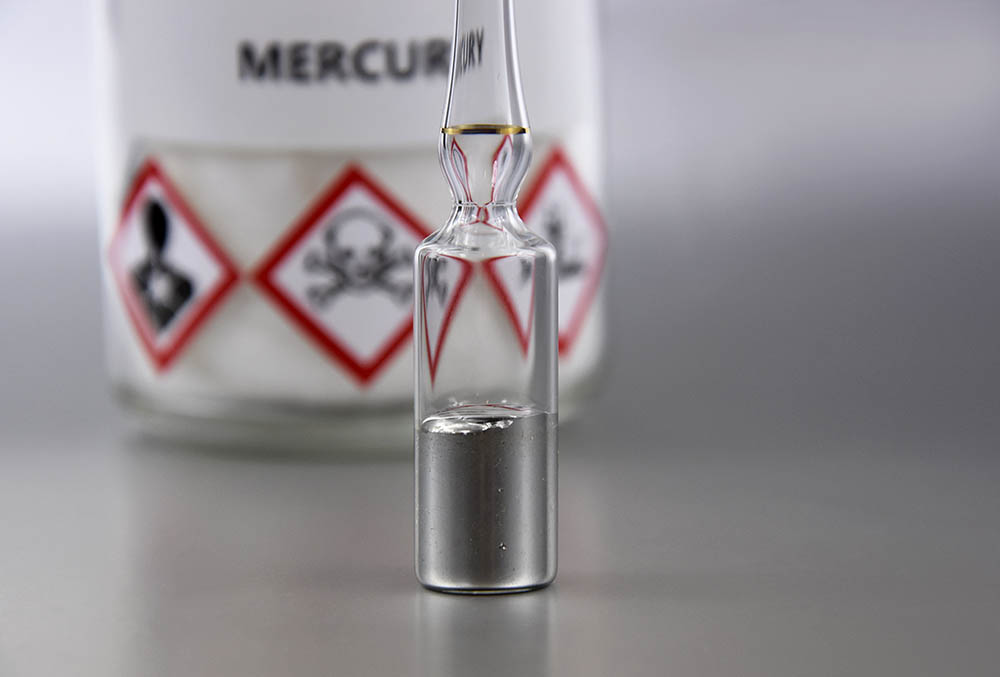Dog Mercury Poisoning: Vet-Approved Causes, Symptoms, and Care

Updated on

You have likely heard of the dangers of mercury thermometers, and that you shouldn’t eat too much tuna or salmon because it contains mercury. But how does this information relate to our canine friends?
Reports of mercury poisoning in dogs are, fortunately, rare now that many items that previously contained mercury (e.g., thermometers) have been replaced with safer alternatives. However, it can still occur.
Mercury is a heavy metal; part of a group that includes other toxic substances like lead, cadmium, and arsenic. It is found throughout the environment in a variety of forms:
- Elemental mercury: used in some thermometers, fluorescent light bulbs, kids’ light-up shoes (pre-1997), and button batteries; vapors are highly toxic
- Organic mercury (e.g., methylmercury): found in aquatic food chains; predator fish have the highest levels due to biomagnification
- Inorganic mercury salts/compounds: used in some industrial processes and for the production of certain chemicals; found in mercuric oxide batteries1
What is Mercury Poisoning?
Simply put, mercury poisoning is toxicity resulting from breathing or ingesting mercury in any of its forms.
- The elemental form of mercury is most likely to be implicated in cases of acute (sudden) poisoning because of its highly toxic vapors.
- Methylmercury can take several weeks to build up to toxic levels in the body, so chronic (long-term) exposure is the main concern with this form.
- Inorganic mercury salts/compounds are generally considered to be less of a concern for poisoning because they are not absorbed well after ingestion but, in large quantities, they can be corrosive to the gastrointestinal (GI) tract.
For the purposes of this article, we will focus on poisoning associated with elemental mercury and methylmercury.

How Do Dogs Get Mercury Poisoning?
Acute Mercury Poisoning
Dogs are most likely to get acute (sudden) mercury poisoning from exposure to vapor released by spilled elemental mercury. Inhaling mercury vapor can quickly result in severe respiratory distress and may even be fatal.
It is critical to get pets (and children) away from mercury spills immediately, and then clean up the spill quickly and safely.
Call the US Pet Poison Helpline at 855-764-7661 or the ASPCA (Animal Poison Control Center) at (888) 426-4435 for further information. Please note there is a fee for using this service.
You may also refer to this handout about mercury spills and pets, from the Michigan Department of Health and Human Services
Chronic Mercury Poisoning
Dogs can develop mercury poisoning from chronic (long-term) exposure to methylmercury. Puppies are most susceptible because their nervous systems are still developing.
Fortunately, current research suggests that commercial pet food diets likely do not contain enough methylmercury to pose a threat to healthy adult dogs. Even a 2012 study with Alaskan sled dogs, whose diets were supplemented with fish and whose fur samples showed high levels of methylmercury (compared to dogs in other geographic regions), did not appear to show signs of toxicity.
What Are the Signs of Mercury Poisoning in Dogs?
Acute Mercury Poisoning
The primary sign of acute mercury poisoning from elemental mercury vapors is severe dyspnea, or trouble breathing, which warrants urgent veterinary attention.

Signs of respiratory distress in dogs are as follows:
- Fast and/or noisy breathing
- Restless, unable to settle, panicked look
- Head and neck extended
- Visible effort with breathing (exaggerated movement of the chest and abdomen)
- Gums and tongue look blue/purple
- Collapse
Sadly, some cases progress quickly and result in death.
Chronic Mercury Poisoning
The signs of chronic (long-term) methylmercury exposure are the result of its effects on the brain and kidneys.

Neurologic signs can take days, weeks, or months to develop and may include:
- Blindness
- Ataxia (general incoordination)
- Muscle tremors
- Unusual behavior
- Highly exaggerated leg movements when walking
- Convulsions
Unfortunately, severe cases may be fatal.
How Do I Care for A Dog With Mercury Poisoning?
If you suspect that your dog may have mercury poisoning, please do not attempt to care for them on your own. Seek veterinary attention right away. Take care to avoid getting scratched or bitten, as some dogs may flail around or unintentionally lash out if they are struggling to breathe or feel disoriented.

If your dog is showing signs of respiratory distress: do your best to keep them quiet and calm, and transport them to the nearest veterinary clinic as quickly as possible.
If your dog is showing neurologic signs: keep them in a safe location (away from stairs, children, and other pets) until you can get them to a veterinarian. Small dogs can be gently wrapped in a towel or blanket and carried. Large dogs may need some assistance walking to your vehicle and getting inside. Make sure to clip them securely to a leash and consider using a towel or blanket “sling” under their belly (close to their hips) to help them balance.
If you suspect that your dog may have been exposed to mercury, be sure to let your veterinarian know! Many signs of mercury poisoning are similar to other medical conditions, and because it does not occur commonly, veterinarians may not immediately consider it as a possibility.
Frequently Asked Questions
How Do I Know If My Dog Has Mercury Poisoning?
If your dog develops respiratory distress from inhaling mercury vapor, you will likely realize right away that something is wrong. If you know that your dog was exposed to an elemental mercury spill, specific testing for mercury poisoning may not be necessary.
Cases of chronic methylmercury poisoning are trickier. Methylmercury gradually builds up in the body and signs may not become apparent for weeks or months. Your veterinarian may tentatively diagnose mercury poisoning based on your dog’s history (especially if there is suspected exposure), clinical signs, and the results of blood and urine tests to evaluate organ function.
Definitive diagnosis of mercury poisoning involves sending tissue samples (often from the kidneys) to a lab for measurement of mercury levels. In many cases, mercury poisoning may not be confirmed until after a patient has passed away.

Can Mercury Poisoning Be Treated?
Unfortunately, there is not much that can be done for dogs with severe respiratory distress from acute elemental mercury poisoning, and the prognosis for recovery is poor.
There is currently no “antidote” for chronic methylmercury poisoning. Treatment focuses on supportive care and preventing additional exposure. The organ damage caused by methylmercury is permanent, so your vet will advise on the best course of action depending on your dog’s organ damage.
How Can I Protect My Dog from Mercury Poisoning?
The good news is that most dogs likely have a very low risk of mercury poisoning, but here are some tips to help keep your pup safe:
- Do not keep items that contain mercury (thermometers, light bulbs) in your home
- Limit the amount of fish your dog eats, especially predator fish that are high on the food chain (e.g., tuna and salmon); this handout can help you make safer choices
- If you regularly catch your own fish and share with your pup, consult local fishing advisories to determine how much is safe to eat
- Ask your pet food company if they test their products for heavy metals, including mercury, and other toxins (this is voluntary)
- Consider avoiding fish-based diets for pregnant dogs and young puppies, who may be especially susceptible to the effects of methylmercury
Fish oil supplements appear to be safe at this time, as they have not been shown to contain significant levels of mercury.
Conclusion
While most exposures to elemental mercury are preventable, it is unlikely that we can completely protect our canine friends from a small exposure to methylmercury through their diet. Fortunately, the studies that have been done to date suggest that current levels of methylmercury in pet food are unlikely to pose a risk for toxicity.
Hopefully, testing of pet food for heavy metals will become mandatory in the future, so that pet parents can make informed choices when selecting a diet for their pup(s).
Measurement of methylmercury levels in individual dogs has been accomplished with non-invasive testing methods such as fur sampling. This could be considered as a tool to screen for mercury exposure in the general canine population, which might identify dogs (or groups of dogs) at risk for toxicity, and allow action to be taken before they start showing signs of mercury poisoning.
Featured Image Credit: BeataGFX, Shutterstock











